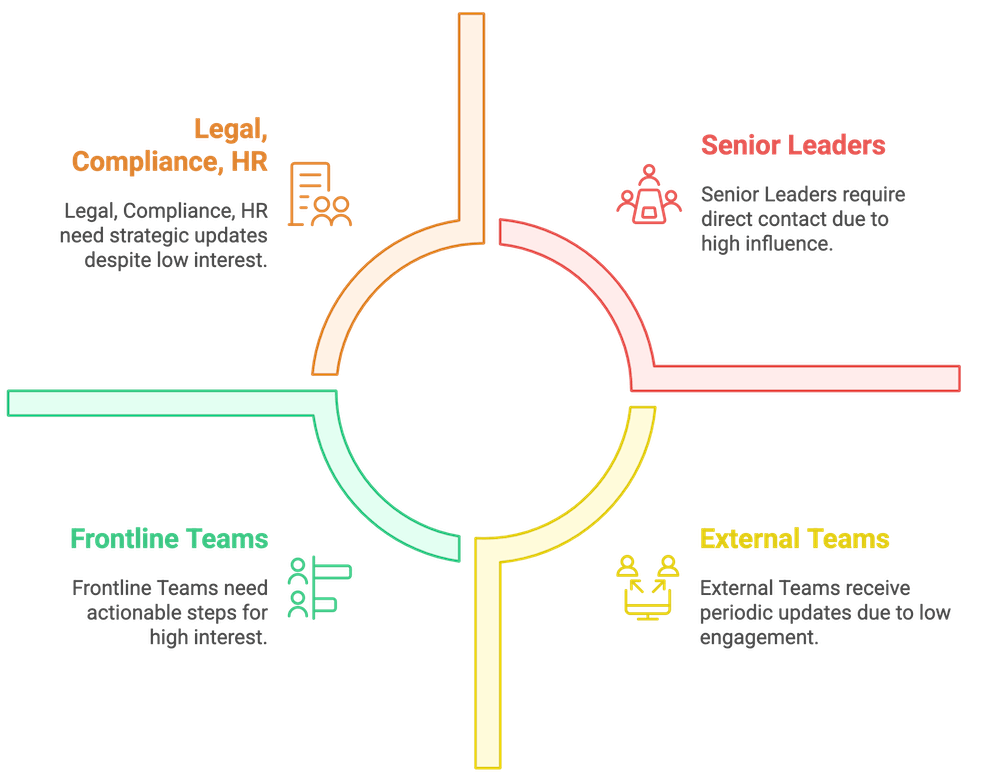Communicating policy changes across a global workforce is one of the most critical yet most challenging aspects of modern organizational management.
With employees spanning diverse countries, cultures, languages, and time zones, an ill-planned announcement can trigger misunderstanding, non-compliance, and even morale issues.
To navigate this complexity effectively, organizations must embrace a strategic, audience-centric communication process.
This article outlines a proven nine-step framework suited for multinationals, remote-first enterprises, and midsize firms aiming to deliver clarity, build trust, and inspire action.
Each section combines practical guidance, real-world cases, and recent research, designed to help professionals confidently drive policy change in even the most complex global environments.
Key Takeaways
- Align communication goals with stakeholder needs for targeted impact.
- Craft clear, concise, and culturally relevant messages.
- Use a multi-channel, sequenced rollout to boost understanding.
- Empower local leaders and peer champions to drive engagement.
- Track adoption, collect feedback, and reinforce consistently.
1. Define Communication Objectives and Stakeholder Segments
Any effective communication strategy begins with two pivotal questions: What outcome are we aiming for? And who needs to receive this message?
Whether the update concerns a new compliance mandate, modifications to remote-work policies, or a company-wide diversity initiative, your answers will determine the tone, urgency, and choice of communication methods.
a. Clarify Your Communication Goals
To design purposeful communication, start by defining the objective:
- Awareness: Are you simply informing employees about an upcoming change?
- Understanding and Alignment: Should the workforce grasp the deeper rationale and objectives?
- Action or Compliance: Is the goal to prompt behavior change or require explicit acknowledgment?
Specifying your end goal ensures all messaging is measured and precise, rather than vague or broad.
b. Segment Your Audience
Not every employee is affected equally or in the same way. Begin by mapping your key stakeholder groups, such as executives, regional leaders, frontline personnel, HR, legal, and external partners.
Then apply a simple power‑interest analysis: who holds influence over the success of this policy, and who will be most impacted.
Based on this mapping:
- High influence and high interest (e.g., senior leadership) may need detailed briefings and direct dialogue.
- High interest and lower influence (e.g., frontline teams) benefit from clear, actionable guidance.
- Lower interest groups might only require periodic summaries.
c. Customize Tone, Depth, and Channel
Each group deserves a tailored approach:
- Tone: Senior leaders may prefer a strategic, big-picture framing, while operational teams will respond better to pragmatic, task‑oriented language.
- Depth: Some groups need only high-level summaries; others require in-depth explanations.
- Channel: Briefing packets and leadership forums work for executives; emails, webinars, and intranet posts suit all staff; one‑on‑one coaching is ideal for managers.
By defining your objectives and segmenting your audience, you build a targeted foundation for communication, one that ensures every message resonates and drives the desired outcome.
When communication fails, so does change, with success rates dropping to just 34%.
Stakeholder Engagement Strategy

2. Craft Clear, Actionable, and Globally Relevant Messages
Communications hinge on precision and relevance. Avoid HR buzzwords and legal jargon that obscure meaning. Every employee, regardless of role or location, should grasp the message immediately.
Key Elements To Include
- What: State the change in plain terms.
- Why: Explain why it matters, both for the organization and for individuals.
- When: Provide clear dates and deadlines.
- Who: Specify which teams or individuals are affected.
- Action: Outline precise steps employees need to take.
- Support: Direct recipients to help resources, training materials, or contacts.
Structure And Formatting
Use visual cues and modular content:
- Begin with a bottom‑line‑up‑front (BLUF) statement that summarizes the key point immediately.
- Apply bullet points, bold formatting, and short paragraphs to aid readability.
- Add an executive summary followed by a stronger rationale, and include an FAQ section to address anticipated questions.
Executive Summaries And FAQs
These components serve different but complementary roles:
- The executive summary offers a snapshot of the policy’s purpose, impact, and next steps, enabling quick comprehension.
- FAQs preempt confusion and reduce follow‑up queries by covering likely concerns and edge cases.
Localization And Cultural Context
Written content must resonate across languages and cultures. Beyond literal translation, adjusting tone, examples, references, and formatting to align with local norms fosters better understanding and engagement.
3. Choose and Sequence the Right Communication Channels
Relying on a single communication platform is rarely effective for a dispersed global workforce. To ensure your message reaches every employee, employ a diverse mix of channels that match different preferences, roles, and contexts.
Recommended Channel Mix
- All‑hands / town halls (live or virtual): Use these for high‑visibility announcements, ideal for sharing big-picture updates and immediate Q&A.
- Email and intranet platforms: Serve as formal records of the policy change; they are ideal for sharing detailed documentation and ensuring traceability.
- Instant messaging tools (Slack, Teams): Best for brief updates, reminders, or prompts that encourage interaction.
- Internal newsletters or digital signage: Reinforce key messages visually in common areas or through summary channels.
- Explainer videos: Particularly useful for complex policy changes; they combine visual and auditory elements to enhance comprehension and retention.
Sequencing Matters
- Launch with a high‑impact channel (e.g., town hall, CEO video message) to establish tone and importance.
- Provide details through structured forums (manager-led sessions, team meetings) where employees can discuss implications and ask questions.
- Reinforce through follow-up channels: send summary emails, update intranet FAQs, circulate a newsletter, and host open Q&A sessions.
Employing multiple channels and repeating core messages to ensure you meet employees where they are and reinforce understanding over time.
4. Engage Local Leaders and Activate Peer Champions
Global communications can’t rely on a single voice; you need local leaders and peer champions to effectively tailor and amplify your message.
Brief Managers and Regional Heads First
Before you launch any policy update, bring your regional managers and team leaders into a preparatory session. Provide them with:
- Talking points and FAQs: Equip them with answers to likely questions.
- Contextual background: Explain the rationale behind the policy and expected benefits.
- Discussion strategies: Offer tips on how to address pushback or sensitive local nuances.
By aligning local leaders early, you ensure consistency and depth in the messaging across regions.
Research indicates that transparent and proactive leadership communication reduces uncertainty and forestalls resistance. Additionally, philosophical models of change confirm that consistent leadership involvement is a key driver of successful transitions.
Activate Peer Champions on the Ground
Select respected individuals within teams to serve as change champions. These peer-level advocates:
- Demonstrate desired behaviors in real-time.
- Answer team members’ practical questions.
- Keep momentum by reminding peers of the change benefits and next steps.
Studies show organizations with active peer champions are over 1.5 times more likely to hit change goals.
Adapt Messages for Cultural and Local Relevance
Avoid simply translating content. Instead, empower local leaders to adapt to it:
- Substitute region-specific examples and analogies.
- Ensure language reflects local expressions, idioms, or references.
- Address cultural norms, such as formality, hierarchy, or communication style.
Localized messaging increases resonance, relevance, and acceptance boosts, especially in diverse global settings.
Why Leadership Participation Matters
Scholars consistently highlight the role of leadership commitment in reducing employee resistance and increasing readiness for change .
Furthermore, participative or shared leadership approaches where local voices contribute build greater intrinsic motivation and organizational citizenship behavior.
5. Provide Employee Training and Policy Support Resources
When policy changes introduce new systems, procedures, or expected behaviors, simply announcing the update isn’t enough. Employees require structured support to understand, internalize, and apply the changes effectively.
- Host live webinars to engage participants and address questions in real-time.
- Provide recorded sessions so employees can review content anytime, accommodating diverse schedules.
- Publish concise guides and demo clips to support clear, on-demand learning references.
- Create a centralized intranet hub with training materials and downloadable resources.
- Use interactive video formats and micro-learning modules to maximize retention and engagement.
By coupling live instruction with concise visual aids and a well-organized repository, your organization delivers multi-modal, accessible training, driving deeper understanding and long-term adoption of new policy requirements.
6. Enable Two-Way Feedback and Open Communication Loops
Effective change communication is a two-way process, not a one-sided announcement. Employees confronted with unfamiliar policies benefit from structures that allow them to ask questions and express concerns.
Deploying surveys, pulse checks, and forums enables leaders to collect real-time sentiment, helping to surface confusion or resistance before issues escalate.
Equipping managers to lead Q&A sessions or open “office-hour” discussions encourages immediate dialogue, fostering understanding and reducing anxiety.
These interactions demonstrate that leadership values employee voices, reinforcing trust and psychological safety.
Additionally, anonymous feedback channels allow employees to share honest insights without fear, making them more likely to flag genuine concerns. Research shows that 73% of employees undergoing organizational change experience moderate to high stress, and offering meaningful ways to speak up significantly reduces resistance.
By embedding active listening in policy rollout, organizations build transparency, trust, and increased adaptability, making change smoother and more sustainable.
7. Ensure Easy Access, Visibility, and Policy Transparency
To support sustained compliance and clear communication, policy updates must be easy to find, understand, and track over time. Ensuring transparent access protects the organization and empowers employees to stay informed.
- Store updated policy versions in a clearly labeled central repository, such as a “Policy Library,” ensuring easy, consistent access for all.
- Use version control with dates and “what changed” summaries to chronicle revisions and maintain accountability.
- For essential policy changes, mandate employee acknowledgment via digital signatures or read receipts to confirm they’ve reviewed new content.
- Send automated reminder notifications to employees or teams who haven’t acknowledged updates, reinforcing compliance and completion.
8. Track Policy Adoption and Reinforce Through Continuous Communication
Communication doesn’t end at launch; ongoing monitoring and active reinforcement are essential to cement policy changes. Track key adoption metrics such as email open rates, intranet page views, training completion percentages, and policy acknowledgment rates.
These indicators function like a compliance health check, surfacing gaps before they escalate. Share compliance dashboards or scorecards with leadership to foster accountability and maintain visibility into adoption trends.
Integrate policy reminders and related discussions into routine meetings and retrospectives to keep the change present in daily operations. Highlighting success stories, such as a regional team identifying a compliance gap early, reinforces the practical value of the policy and helps build positive internal narratives.
Continuous reinforcement embeds the change into organizational culture, making compliance habitual rather than exceptional.
By regularly reviewing performance and celebrating constructive behaviors, you create a feedback cycle that prevents drift and sustains long-term policy adherence.
Common Pitfalls & How to Avoid Them
It’s important to recognize that even well-structured communication plans can falter without strategic foresight and adaptability.
Understanding typical missteps, such as inconsistent messaging, insufficient engagement, or misaligned timing, helps you proactively design solutions and keep your policy implementation on track.
| Pitfall | Risk | Mitigation |
| One-size-fits-all announcements | Confusion, cultural backlash | Localize and segment messages |
| Overuse of HR/legal jargon | Disengagement | Use plain, direct, relatable language |
| Single-channel reliance | Low reach and attention | Set up dashboards, reminders, and success stories |
| Skipping feedback loops | Missed concerns and resistance | Provide two-way communication options |
| No reinforcement post-launch | Message fades, low adoption | Track KPIs, report to leaders, and iterate improvements |
| Missing measurement and reporting | No insight into the effectiveness | Track KPIs, report to leaders, iterate improvements |
Learn from Real-World Case Studies and Avoid Common Policy Rollout Pitfalls
It’s important to recognize how organizations have successfully navigated policy communication and change through practical application.
These case studies demonstrate how tailored strategies, from leadership engagement to peer-driven advocacy, can drive meaningful adoption and reinforce change across diverse operational contexts.
Scandinavian Airlines (1980s overhaul)
Faced with a major strategic shift, SAS distributed a visual “story handbook” to 20,000 employees, reframing the change as a collective narrative. The result: escalated earnings of $25 million in the first year and $80 million overall.
TechSmith (Software company)
Emphasized the power of visual and video communication, acknowledging that visuals lead to faster understanding and deeper recall than text alone.
PT X in Indonesia (2021 restructuring)
Global CEO announced changes early; local managers applied tailored communication in local languages and cultural contexts. The result: smoother transitions and higher acceptance among local teams.
Conclusion
Communicating policy changes across a global workforce isn’t just a procedural necessity; it’s a strategic lever for building organizational trust, cohesion, and long-term resilience.
When done right, it deepens employees’ understanding of the change, boosts confidence in leadership, and drives stronger compliance across every region and team.
By following the nine-step framework, from defining clear goals and segmenting stakeholders to activating local leadership, enabling feedback, ensuring accessibility, and reinforcing adoption, you create a structured, repeatable process that guides your organization through change with purpose and clarity.
Backed by research and real-world results, this approach empowers leaders to build transparency, strengthen engagement, and embed change into daily operations.
Ultimately, it transforms policy rollouts from top-down announcements into meaningful, collaborative moments that help your workforce not just navigate change, but embrace it.











